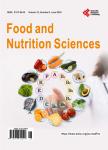Study of the Nutritional Value and Hygienic Quality of Local Infant Flours from Chad, with the Aim of Their Use for Improved Infant Flours Preparation
Study of the Nutritional Value and Hygienic Quality of Local Infant Flours from Chad, with the Aim of Their Use for Improved Infant Flours Preparation作者机构:Department of Biochemistry and Microbiology Research Center in Biological Food and Nutritional Sciences (CRSBAN) Unit of Formation and Research in Life and ground Sciences University of Ouagadougou Ouagadougou Burkina Faso Department of Biochemistry and Microbiology Research Center in Biological Food and Nutritional Sciences (CRSBAN) Unit of Formation and Research in Life and ground Sciences University of Ouagadougou Ouagadougou Burkina Faso Department of Biology Faculty of Sciences (FSEA) University of N’Djamena N’Djamena Chad.
出 版 物:《Food and Nutrition Sciences》 (食品与营养科学(英文))
年 卷 期:2013年第4卷第9期
页 面:59-68页
学科分类:1002[医学-临床医学] 100214[医学-肿瘤学] 10[医学]
主 题:Childhood Flours Nutritional Value Hygienic Quality Fortification Chad
摘 要:This study aims to develop infant flours fortified with iron and vitamin A, taken from local products such as powder from dried Moringa oleifera leaves and pulps of Parkia biglobosa to improve the nutritional status of children aged 6 to 24 months. Chemical analyses show that, for 100 g of local flours destined for children, there are adequate protein levels (between 7.00 ± 0.44 and 12.69 ± 0.44 g) and fat content (between 7.52 ± 0.35 and 16.26 ± 0.84 g), but that there are low levels of b-carotene and certain micronutrients Zn (0.67 ± 0.01 to 2.51 ± 0.19 mg), Fe (7.11 ± 0.90 to 12.70 ± 0.56 mg), Ca (0.67 ± 0.01 to 2.51 ± 0.19 mg), Mg (6.79 ± 0.19 to 24.99 ± 1.75 mg). Analyses of minerals and vitamins showed that Moringa oleifera leaf-powder (per 100 g) is rich in calcium (1443.90 ± 11.03 mg), magnesium (176.72 ± 0.73 mg), iron (53.75 ± 5.07 mg), zinc (17.58 ± 0.89 mg) and b-carotene (624.40 ± 0.41 μg ER). 100 g of Parkia biglobosa’s pulps is rich in magnesium (73.00 ± 1.14 mg), iron (14.82 ± 2.49 mg), zinc (7.79 ± 0.44 mg) and vitamin C (75.29 ± 0.00 mg). In conclusion, we believe that these two ingredients can be effectively used to fortify local infant flours in vitamin A and iron and contribute to eradicating malnutrition due to micronutrients deficiencies.



